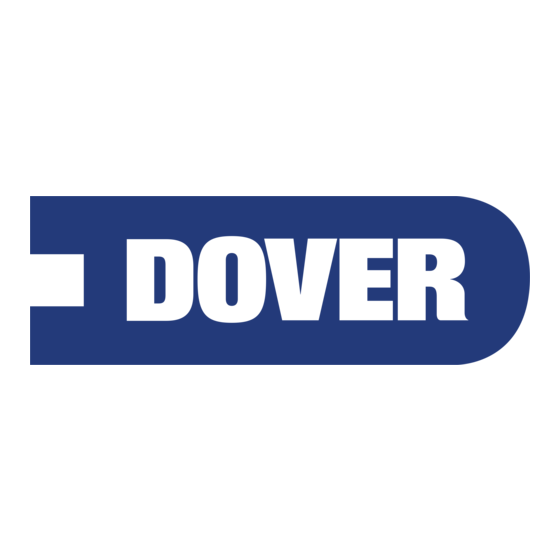Dover Blackmer DMX IV Manuel - Sayfa 6
Endüstriyel Ekipmanlar Dover Blackmer DMX IV için çevrimiçi göz atın veya pdf Manuel indirin. Dover Blackmer DMX IV 15 sayfaları. Air elimination system

4. SYSTEM CONSIDERATIONS (continued)
4.4 SETTING HIGH FLOWRATE
Adjustment MUST be made with the pump at the opera-
ting speed required for the desired flowrate and with
maximum air pressure applied to the air relief valve.
Setting of high flowrate is done by :
• Controlling the pump rpm
• Controlling the high pressure setting inside the ACP
• Controlling the line losses in the system
The high pressure setting inside the ACP controls the
maximum air pressure going to the pump air relief valve
through the DMX when the flow detector is activated.
The air pressure on the pump relief valve controls the
maximum product pressure downstream of the pump.
The flowrate will stabilize when the line losses behind
the pump equal the discharge pressure of the pump.
It is Blackmer's field experience that when a truck is desi-
gned for dual use, utilizing a 3" TXD3 Pump, the( ACP ) Air
Control Panel regulators should be set at 100 PSI on the Hi
Pressure Regulator and 50 to 55 PSI on the Low Regulator.
This will allow the pump to overcome back pressure crea-
ted utilizing 1 1/4" or 13/8" hose and nozzle.
IN CONDITIONS WHERE THE LINE LOSSES FROM THE TANK TO
THE DMX ARE EQUAL TO THE MAXIMUM INLET VACUUM
ACCEPTABLE INSIDE THE DMX, DMX WILL CREATE FLOW
CYCLING. THIS PHENOMENON WILL LIMIT THE MAXIMUM FLO-
WRATE OBTAINABLE AND MUST BE CORRECTED BY REDU-
CING THE LINE LOSSES FROM THE TANK TO THE DMX.
To increase maximum flowrate :
• Increase pump rotation speed
• Increase the setting of the high pressure regulator of
the ACP. Check in the appropriate IOM for the maxi-
mum allowable pressure to each Blackmer component.
• Reduce the line losses between the pump discharge
and the hose/delivery nozzle (increase piping diame-
ter, hose diameter, reduce number of elbows and
valves, nozzle size, reduce the length of hose, etc)..
TO AVOID DAMAGE TO THE PUMP AIR/RELIEF VALVE (9C) DO
NOT OVERPRESSURE THE RELIEF VALVE.
In cases where downstream restrictions reach the set
pressure of the relief valve before the flowrate matches
the pump speed, the pump will go into bypass and recir-
culate fluid through the pump internal relief valve.
In those situations, increasing the maximum pressure
setting of the ACP will not lead to significant flowrate
increase. Reduce the restrictions in the discharge piping.
To check for pump over speeding, position the system in
its maximum flowrate configuration (empty hose, nozzle
fully open, hose unwound from hose reel, etc.) Reduce
the pump speed by steps, allowing one minute to stabi-
lize the flowrate between each step. Record the last rpm
value before a flowrate reduction may be noticed.
Set the high pressure regulator and pump rotational
speed to limit the recirculation flowrate through the internal
relief valve.
NT 201B-A00 04.06 DMX IV Air elimination system e
NOTICE :
NOTICE :
Some installations will require the limiting of flowrate
and/or pump discharge pressure. For example :
• To reduce the creation of foam in customer tanks
• To allow easier hose handling during delivery
Reduce the setting of the ACP high pressure regulator to
reduce the maximum flowrate.
Check the ACP IOM for the minimum differential setting
between the high pressure and low pressure setting.
After setting the regulator pressure, push down on the
air regulator adjusting knob to it lock in position.
4.5 SETTING THE FLOWRATE AND ENGINE SPEED
THE AIR RELIEF VALVE LOW PRESSURE SETTING REGULATES
THE DELIVERY HOSE PRESSURE WHEN THE NOZZLE IS CLO-
SED. ADJUST THE AIR VALVE ONLY HIGH ENOUGH TO OPEN
THE FLOW DETECTOR/CHECK VALVE AND DELIVER THE
REQUIRED LOW FLOWRATE.
At the beginning of the delivery, it is important that the
flowrate and pump discharge pressure are reduced :
• Hose handling is easier when discharge pressure is lower.
• When operating against a closed nozzle, lower dis-
charge pressure reduces horsepower required and
heat buildup in the pump.
In most operations, users will want flowrates to increase
to the maximum as quick as safely possible when delivery
is started.
In some operations, like small tank filing or topping off
tanks, users do not want high flow or high pressure. In
these cases, limit the stabilized flowrate by reducing the
opening of the delivery nozzle and do not allow the engine
speed to increase.
By controlling the setting of the DMX IV Air Elimination
System, truck acceleration and increased pump relief
valve pressure can be prevented. This may be done
without the need for a specific switch on the Truck Fuel
Delivery control panel.
To ensure that the Flow Detector is properly set :
• Determine the desired flowrate when in operation
without the engine speed being increased.
• Set the low pressure regulator of the ACP to its
lowest setting.
• Recirculate the product through the pumping system
and DMX to a tank compartment that is at least half
full and has at least 260 gallons (1000 liters) inside.
• Run the pump at the normal engine speed.
• Recirculate the fluid through the delivery hose to an
empty compartment/tank. NOTE : Remove ALL the
hose from the hose reel to reduce restrictions.
• Increase the ACP low pressure setting in 5 PSI
(0,34 bar) increments, letting the system stabilize in
flow for one minute between each adjustement.
Record the flowrate.
• The Flow detector is triggered when no air is venting
from its exhaust port. When this occurs, output 3 and
5 of the ACP should be at high pressure. If no ven-
ting occurs inside the DMX, port 4 will also be at that
high pressure.
6/15
NOTICE :
